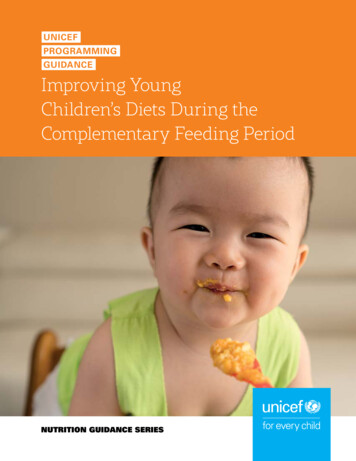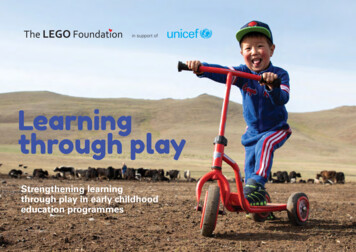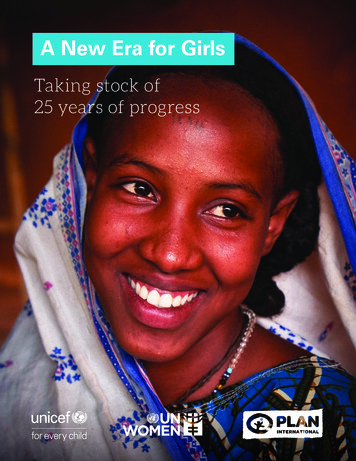
Transcription
UNICEFPROGRAMMINGGUIDANCEImproving YoungChildren’s Diets During theComplementary Feeding PeriodNUTRITION GUIDANCE SERIES
AcknowledgementsThis publication was prepared by the Nutrition Section at UNICEFProgramme Division in New York.Lead authors: Aashima Garg, France Bégin and Víctor Aguayo.Technical reviewers and contributors in UNICEF (in alphabetical order):Yousif Almasri, Yarlini Balarajan, Jessica Blankenship, Kudawashe Chimanya,David Clark, Michael Emerson Gnilo, Chika Hayashi, Diane Holland, Ana Nieto,Anne-Sophie Le Dain, Jo Jewell, Atif Khurshid, Julia Krasevec, Chessa Lutter(consultant), Isabel Madzorera (consultant), Joan Matji, Vrinda R Mehra,Grainne Mairead Moloney, Sheila Murthy (consultant), Reuel Kirathi Mungai,Zivai Murira, Louise Mwirigi, Mara Nyawo, Luwei Pearson, Christiane Rudert,Mawuli Sablah, Ruth Situma, Joseph Senesie, Harriet Torlesse, Megan Tucker,Vilma Tyler, Jessica White (consultant), Amirhossein Yarparvar,and Noel Marie Zagre.Contributions were also gathered from governments and partner organizationsthrough regional consultations held for adapting the global action framework toregional context in East Asia and the Pacific, Eastern and Southern Africa, andSouth Asia.UNICEF recognizes the support by the Government of the Netherlandsand the Bill and Melinda Gates Foundation for the development of thisprogramme guidance.Editor: Julia D’AloisioDesigner: Nona ReuterCitation: United Nations Children’s Fund (UNICEF). Improving Young Children’sDiets During the Complementary Feeding Period. UNICEF Programming Guidance.New York: UNICEF, 2020.February 2020Photography credits: Cover: baolyan/stock.adobe.com; page 8: UNICEF/NinaGorshkova; page10: UNICEF/UN0150210/Dejongh; page 13: UNICEF/Pirozzi;page 16: ztony1971/stock.adobe.com; page 20: UNICEF/UNI109215/Pirozzi;page 23: UNICEF/UN075308/Kealey; page 24: UNICEF/UN0253468/Labrador;page 26: UNICEF/UN039141/Noorani; page 28: UNICEF/UN0120487/Sharma;page 30: UNICEF/UN0311058/Verweij; page 35: UNICEF/UN0150302/Dejongh; page 46: UNICEF/UN0343201/Pazos; page 50: UNICEF/UNI235999/Noorani; page 59: UNICEF/UNI235461/Willocq.
ContentsAbbreviations3Definitions41. Introduction62. Why children’s diets matter during the complementary feeding period83. Dimensions of children’s diets during the complementary feeding period113.1 What children eat123.2 When and how children are fed154. Determinants and drivers of young children’s diets during the complementary feeding period184.1 Adequate foods194.2 Adequate services204.3 Adequate practices205. Evidence on what works for improving young children’s diets225.1 Nutrition counselling and social and behaviour change communication235.2 Counselling and education on responsive feeding and stimulation235.3 Access to diverse and nutritious complementary foods at household level235.4 Use of vitamin and mineral supplements in settings where nutrient-poor diets prevail255.5 Access to fortified foods as needed, aligned with global and national standards255.6 Access to affordable and nutritious foods through social protection programmes and counsellingservices255.7 Access to safe water and clean household environments for young children266.Action framework to improve the diets of young children during the complementary feeding period 286.1 Elements of the Action Framework296.1.1 Situation analysis to understand the status and drivers of young children’s diets296.1.2 Determinants and drivers of young children’s diets316.1.3 Implementing strategic actions through systems326.1.4 Programming context326.1.5 Monitoring, evaluation and learning326.2 Delivering strategic actions through systems356.2.1 Action Framework for Delivering through the Food System376.2.2 Action Framework for Delivering through the Health System396.2.3 Action Framework for Delivering through the Water and Sanitation System416.2.4 Action Framework for Delivering through the Social Protection System43Improving Young Children’s Diets during the Complementary Feeding Period 1
7. Monitoring, evaluation and learning447.1 Measuring progress on improving young children’s diets457.2 Programme monitoring and evaluation457.3 Knowledge management and learning478. Applying the programming guidance48Endnotes50Annexes57Annex 1: Evidence-based interventions to improve complementary feeding and their associationwith child feeding and growth outcomes58Annex 2: Tools for complementary feeding programming62Annex 3: Core components of situation analysis for complementary feeding programming64Annex 4: Assessing availability, promotion and perception of commercially produced complementaryfoods, snacks and beverages66Annex 5: Resources, tools and useful links related to improving young children’s diets67Annex 6: Illustrative results matrix to guide monitoring and evaluation to improve children’s diets68Annex Endnotes712 UNICEF Programming Guidance
AbbreviationsASFAnimal-source foodsUNUnited NationsARCHAssessment and Results on ChildFeedingUNICEFUnited Nations Children’s FundBMIBody mass indexWASHWater, sanitation and hygieneC4DCommunications for developmentWAZWeight-for-age Z-scoreCFComplementary feedingWHAWorld Health AssemblyDHSDemographic and Health SurveysWHOWorld Health OrganizationFAOFood and Agricultural OrganizationWHZ orWLZWeight-for-height or weight-for-lengthZ-scoreHAZ orLAZHeight for age or length for ageZ-scoreHMISHealth management informationsystemsIYCFInfant and young child feedingLMICsLow and middle-income countriesMADMinimum acceptable dietMDDMinimum dietary diversityMELMonitoring, evaluation and learningMICSMultiple Indicator Cluster SurveysMMFMinimum meal frequencyMNPsMicronutrient powdersNCDsNon-communicable diseasesNGOsNon-governmental organizationsORSOral rehydration solutionRAMResults assessment moduleSBCCSocial and behavior changecommunicationSDGsSustainable development goalsSMQStrategic monitoring questionsSSBsSugar-sweetened beverages (alsocalled soft drinks)SQ-LNSSmall quantity-Lipid-based nutrientsupplementsImproving Young Children’s Diets during the Complementary Feeding Period 3
DefinitionsAnimal-source foods: Foods derived from animals,such as eggs, meat (beef, chicken, goat, etc.), anddairy products (milk, cheese, yoghurt, fermentedmilks, etc.).Breastmilk substitute: Any food or drink beingmarketed or otherwise represented or used as apartial or total replacement for breastmilk. RecentWHO guidance clarifies that breastmilk substitutesinclude any milks that are specifically marketed forfeeding children from birth to 3 years of age.Codex Alimentarius standard: a standard adoptedby the Codex Alimentarius Commission (thecentral part of the Joint FAO/WHO Food StandardsProgramme) to protect consumer health and promotefair practices in food trade.Complementary foods: Solid, semi-solid andsoft foods (both locally prepared and commerciallymanufactured) provided to children between the agesof 6 and 23 months to complement breastmilk.Commercial complementary foods: Fortifiedor unfortified complementary foods that arecommercially processed (either locally orinternationally) and available in the market.Follow-up formula: A milk or milk-like productof animal or vegetable origin that is industriallyformulated in accordance with national standardsor the Codex Alimentarius Standard for Follow-upFormula and marketed or otherwise represented assuitable for feeding infants and young children olderthan 6 months of age.Growing up milk: A milk product marketed forchildren between 1 and 3 years of age. Theseproducts are not necessary for good child nutrition.4 UNICEF Programming GuidanceInfant formula: A milk or milk-like product ofanimal or vegetable origin industrially formulated inaccordance with national standards, or the CodexAlimentarius Standard for Infant Formula, andintended to satisfy the nutritional requirements ofinfants during the first 6 months.First foods: See complementary foods.Fortified complementary foods: Complementaryfoods that are specifically formulated to provideadditional energy and/or nutrients. These foods canbe locally or commercially produced.Home fortification: Also referred to as point-ofuse fortification. An approach to improving the dietquality of nutritionally vulnerable groups, such asyoung children, by adding micronutrient powder(see ‘micronutrient powders’) or specialized fortifiedproducts (such as lipid-based supplements) to homeprepared foods.Micronutrient powders (MNPs): Dry powderwith micronutrients (vitamins and minerals) that canbe added to any solid, semi-solid or soft food thatis ready for consumption. MNPs are provided insachets.Nutrient-dense/rich foods: Foods with highmicronutrient content in relation to weight. Nutrientdense foods also contain sufficient macronutrients(i.e., energy and protein). Examples include legumes,nuts and seeds, animal-source foods and dark greenand orange fruits and vegetables.Processed foods: Foods that have beencommercially prepared or packaged using baking,canning, drying or freezing. Not all processed foodsare unhealthy, but some highly or ultra-processedfoods (e.g., ready-to-eat meals and snack foods)contain high levels of salt, sugar and unhealthyfat, which have been shown to increase the risk ofoverweight, obesity and chronic diseases.
Responsive feeding: An approach to feeding wherecaregivers encourage children to eat, provide food inresponse to the child’s appetite and satiety signals,and feed their children with care. Responsive feedinghelps children develop healthy eating habits.The Code: The International Code of Marketing ofBreast-milk Substitutes and all subsequent relevantresolutions adopted by the World Health Assembly.The Code aims to prohibit all forms of promotionof breastmilk substitutes, including infant formula,feeding bottles and teats.Street Foods: Prepared or cooked foods forimmediate consumption sold by vendors on the streetor in other public locations.Young child: A child aged 6–23 months, in thecontext of this Programming Guidance.Sugar-sweetened beverage: Any liquid that issweetened with added sugar, such as brown sugar,corn sweetener, corn syrup, dextrose, fructose,glucose, high-fructose corn syrup, honey, lactose,malt syrup, maltose, molasses, raw sugar, andsucrose.Improving Young Children’s Diets during the Complementary Feeding Period 5
1.Introduction6 UNICEF Programming Guidance
The right to adequate nutrition is a fundamental rightfor every child. Children who are fed enough of theright foods, in the right way, at the right time in theirdevelopment, are more likely to survive, grow, developand learn. They are better equipped to thrive, evenwhen faced with disease, disaster or crisis.Between the ages of 6 and 23 months – thecomplementary feeding period – breastfeeding andaccess to a diverse range of nutritious foods providechildren with the essential nutrients, vitamins, andminerals they need to develop to their full physicaland cognitive potential, with benefits that endure wellinto adulthood.1, 2 The complementary feeding periodis also a critical opportunity to prevent all forms ofchildhood malnutrition, including stunting, wasting,micronutrient deficiencies, overweight, obesity anddiet-related non-communicable diseases. In addition,lifelong food preferences, tastes and habits are oftenestablished in childhood.Yet in nearly every part of the world, families faceeconomic, political, market, social or cultural barriersto providing nutritious, safe, affordable and sustainablediets to young children. These challenges areexacerbated in humanitarian situations, where accessto nutritious food, clean drinking water, and goodquality health services are limited, and the resourcesand capacities of caregivers already stretched. Youngchildren and their caregivers are increasingly exposedto foods of low nutritive value, including commercialcomplementary foods and processed foods high inadded sugar, salt and saturated and trans fats that areinexpensive, ubiquitous, and easy to feed to youngchildren. 3 Accelerating progress to improve the qualityof complementary foods and feeding practices foryoung children is therefore critical.4This Programming Guidance, Improving YoungChildren’s Diets During the Complementary FeedingPeriod,* supports global efforts to improve the dietsof children aged 6–23 months in all contexts.** It isintended for use by UNICEF staff in programmes suchas nutrition, health, early childhood development,water, sanitation and hygiene and social policy – inregional, country and field offices – to support thework of governments and partner organizations.Previous UNICEF guidance on infant and youngchild feeding focused mainly on evidencebased interventions and strategies for improvingcomplementary feeding practices within thehousehold.5 This Programming Guidance goes beyondfeeding practices to articulate interventions andapproaches for improving the availability, accessibility,affordability and consumption of nutritious and safecomplementary foods. In addition, this ProgrammingGuidance describes the most recent evidence onimproving complementary feeding, explores thedeterminants and drivers of young children’s diets, andpresents action frameworks for delivering nutritionresults for children through the food, health, waterand sanitation, and social protection systems. It alsoprovides guidance on monitoring and evaluatingcomplementary feeding programmes and outcomes.* The terms complementary foods/feeding and diets for young children are used interchangeably in this document.** In both development and humanitarian programming contexts.Improving Young Children’s Diets during the Complementary Feeding Period 7
2.Why children’sdiets matterduring thecomplementaryfeeding period8 UNICEF Programming Guidance
The quality of children’s diets is more importantbefore age 2 than at any other time in life.4, 6Appropriate complementary foods and feedingpractices contribute to child survival, growth anddevelopment; t
4.3 Adequate practices 20 5. Evidence on what works for improving young children’s diets 22 5.1 Nutrition counselling and social and behaviour change communication 23 5.2 Counselling and education on responsive feeding and stimulation 23 5.3 Access to diverse and nutritious complementary foods at household level 23 5.4 Use of vitamin and mineral supplements in settings where nutrient-poor .











